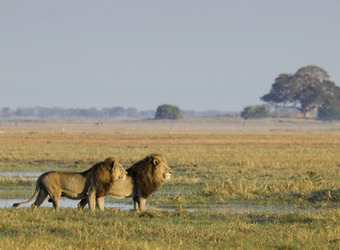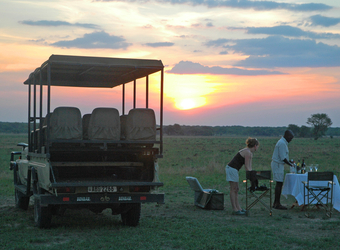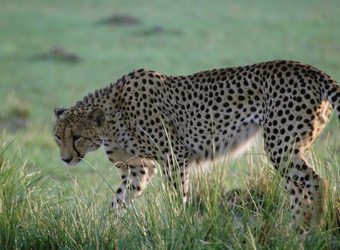Kafue Nat'l Park
| Read Reviews | Write a Review Start Planning Your Custom Safari
 view larger image
view larger image
Established in the 1950s, Kafue is the third largest park in Africa. Yet it remains largely unexplored, with 67% designated as wilderness where only walking safaris are permitted. The Busanga Plains are the park’s prized jewel. Seasonal floods generate vast grazing areas for huge herds of buffalo and rare antelope. Kafue is also one of the best places in Africa to see leopard. Lion and cheetah are common, and wild dog are increasingly seen.
 view image gallery
view image gallery
The Safari Experience
The Busanga Plains of Kafue are almost reminiscent of East Africa, with wide-open floodplains dotted with tree islands and contained by a ring of woodlands. For a national park, the privacy is unrivaled. The first impression of this landscape is from above as you fly in over miombo woodlands broken only by gold and green grasslands that await exploration in open 4x4 safari vehicles and on foot. Rising early reveals fog blanketing the flat plain that extends for miles beyond the decks of the camp. After a light breakfast, head out to look for the unique species harbored within this important wetland ecosystem. Return for a sumptuous brunch and siesta overlooking the savanna before returning to the plains in search of different animals and environs by late afternoon. Sunset cocktails are served in the bush, followed by dinner and a chance to seek out nocturnal life by spotlight at night.
 view image gallery
view image gallery
Wildlife
Envision pulling up beneath a large sycamore fig and peering up to find three lions sprawled across the broad branches, sleeping or gently panting, all trying to escape the heat of the wide, unshaded floodplain. This is an experience distinctive of Kafue. Huge herds of buffalo create giant black shapes from above. Special antelope, like the puku, oribi, roan and red lechwe, are found in sizeable numbers here, along with zebra and wildebeest. Cheetah are common in the Busanga Plains, due to the openness and good visibility to watch for prey. Even wild dog are sometimes encountered. The Busanga Plains are some of Zambia’s most significant wetlands, home to 491 bird species including half the world’s wattled crane, and plenty of rollers, kingfishers, bee-eaters, herons and large flocks of migrating storks drawn to the diverse floodplain, woodland, open water and riverine habitats.
 view image gallery
view image gallery
How to Include Kafue National Park in Your Safari Itinerary
Recommended Number of Nights
Nature Travelers: 3 nights
Photographers: 3 nights
Families: 3 nights
Active Travelers: 3 nights
Other Regions to Include
Zambia has extensive tracts of wildly pristine habitat and is and home to Africa’s best walking safaris. Kafue’s unique habitats and seclusion are well complemented by the wooded and riverine environs of South Luangwa National Park, where the walking safari originated. Here you will see elephant and Thornicroft’s giraffe that do not exist in Kafue’s Busanga Plains. Lower Zambezi National Park adds the element of being on the Zambezi River against a scenic escarpment. Canoeing and fishing are appealing pastimes here, along with walks and wildlife drives, searching for tree-climbing lions, abundant elephant, leopard, and plentiful crocodile and hippo that fill the river. Finally, Victoria Falls is a great way to end your safari. Mosi-oa-Tunya National Park on the Zambia side of the falls offers an opportunity to see rhino. Beyond Zambia, Botswana’s Linyanti or Okavango Delta is another great combination, with a similar sense of wild, unfenced, off-the-grid nature in a completely unique ecosystem with a wide variety of different animals.
